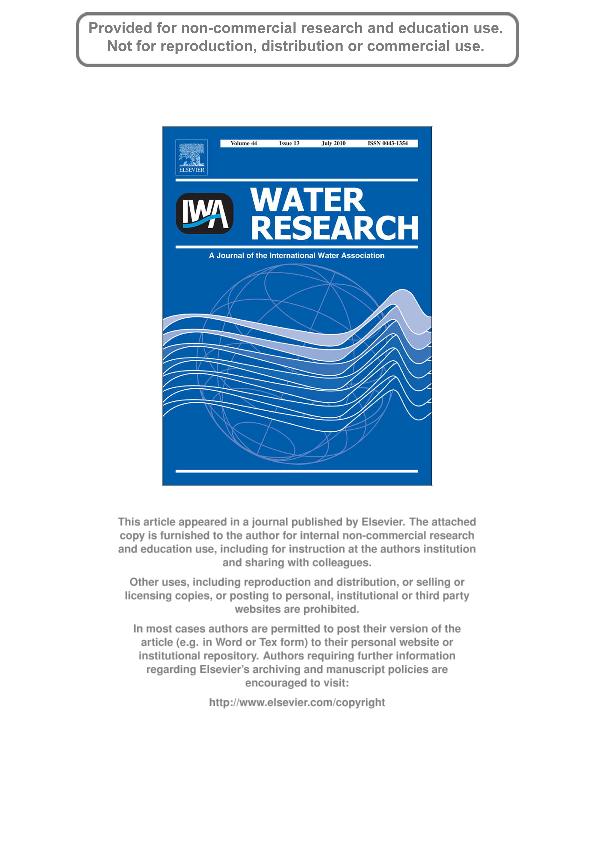Mostrar el registro sencillo del ítem
dc.contributor.author
Manassero, Agustina

dc.contributor.author
Passalia, Claudio

dc.contributor.author
Negro, Antonio Carlos

dc.contributor.author
Cassano, Alberto Enrique

dc.contributor.author
Zalazar, Cristina Susana

dc.date.available
2017-03-01T21:10:14Z
dc.date.issued
2010-05
dc.identifier.citation
Manassero, Agustina; Passalia, Claudio; Negro, Antonio Carlos; Cassano, Alberto Enrique; Zalazar, Cristina Susana; Glyphosate degradation in water employing the H2O2/UVC process; Pergamon-elsevier Science Ltd; Water Research; 44; 5-2010; 3875-3882
dc.identifier.issn
0043-1354
dc.identifier.uri
http://hdl.handle.net/11336/13444
dc.description.abstract
Glyphosate is the organophosphate herbicide most widely used in the world. Any form of spill or discharge, even if unintentional, can be transferred to the water due to its high solubility. The combination of hydrogen peroxide and UV radiation could be a suitable option to decrease glyphosate concentration to acceptable limits. In this work, the effects of initial pH, hydrogen peroxide initial concentration, and incident radiation in glyphosate degradation were studied. The experimental device was a cylinder irradiated with two tubular, germicidal lamps. Conversion of glyphosate increases significantly from pH = 3-7. From this value on, the increase becomes much less noticeable. The reaction rate depends on the initial herbicide concentration and has an optimum plateau of a hydrogen peroxide to glyphosate molar concentration ratio between 7 and 19. The expected non linear dependence on the irradiation rate was observed. The identification of critical reaction intermediaries, and the quantification of the main end products were possible and it led to propose a plausible degradation path. The achieved quantification of the mineralization extent is a positive indicator for the possible application of a rather simple technology for an in situ solution for some of the problems derived from the intensive use of glyphosate.
dc.format
application/pdf
dc.language.iso
eng
dc.publisher
Pergamon-elsevier Science Ltd

dc.rights
info:eu-repo/semantics/openAccess
dc.rights.uri
https://creativecommons.org/licenses/by-nc-sa/2.5/ar/
dc.subject
Glyphosate
dc.subject
Uv/H2o2 Process
dc.subject
Degradation
dc.subject
Reaction Path
dc.subject.classification
Otras Ingeniería Química

dc.subject.classification
Ingeniería Química

dc.subject.classification
INGENIERÍAS Y TECNOLOGÍAS

dc.title
Glyphosate degradation in water employing the H2O2/UVC process
dc.type
info:eu-repo/semantics/article
dc.type
info:ar-repo/semantics/artículo
dc.type
info:eu-repo/semantics/publishedVersion
dc.date.updated
2017-02-24T19:32:22Z
dc.journal.volume
44
dc.journal.pagination
3875-3882
dc.journal.pais
Países Bajos

dc.journal.ciudad
Amsterdam
dc.description.fil
Fil: Manassero, Agustina. Consejo Nacional de Investigaciones Científicas y Técnicas. Centro Científico Tecnológico Santa Fe. Instituto de Desarrollo Tecnológico para la Industria Química (i); Argentina
dc.description.fil
Fil: Passalia, Claudio. Universidad Nacional del Litoral. Facultad de Ingeniería y Ciencias Hídricas; Argentina
dc.description.fil
Fil: Negro, Antonio Carlos. Consejo Nacional de Investigaciones Científicas y Técnicas. Centro Científico Tecnológico Santa Fe. Instituto de Desarrollo Tecnológico para la Industria Química (i); Argentina
dc.description.fil
Fil: Cassano, Alberto Enrique. Consejo Nacional de Investigaciones Científicas y Técnicas. Centro Científico Tecnológico Santa Fe. Instituto de Desarrollo Tecnológico para la Industria Química (i); Argentina
dc.description.fil
Fil: Zalazar, Cristina Susana. Consejo Nacional de Investigaciones Científicas y Técnicas. Centro Científico Tecnológico Santa Fe. Instituto de Desarrollo Tecnológico para la Industria Química (i); Argentina
dc.journal.title
Water Research

dc.relation.alternativeid
info:eu-repo/semantics/altIdentifier/doi/http://dx.doi.org/10.1016/j.watres.2010.05.004
Archivos asociados
